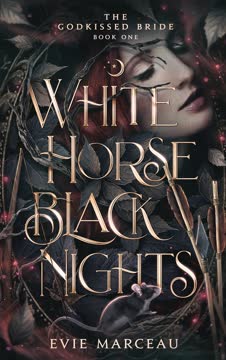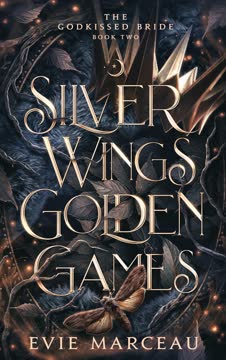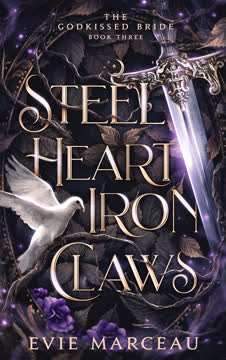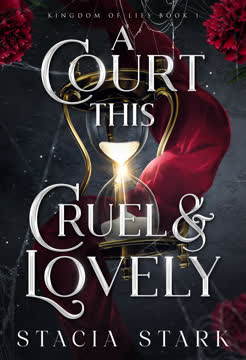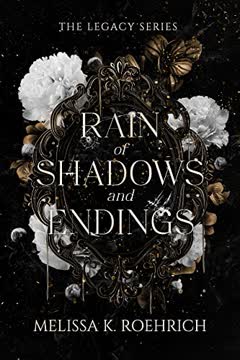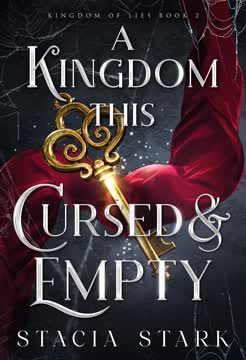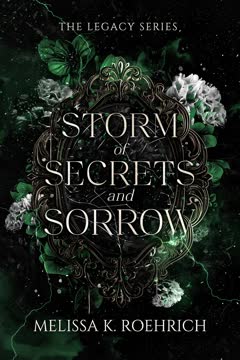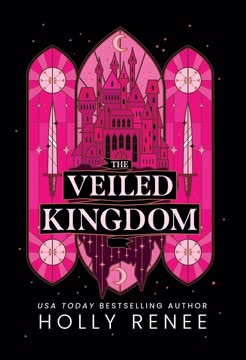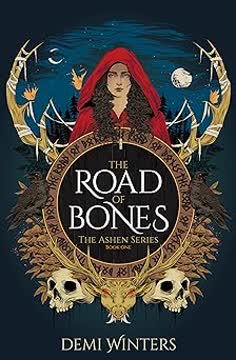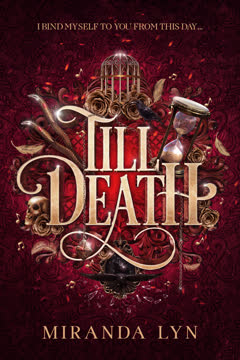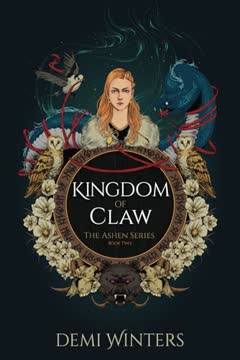Plot Summary
Sold Bride, Shattered Freedom
Sabine Darrow, a young woman marked by the gods ("godkissed"), is sold by her father to Lord Rian Valvere to settle family debts. On the day of her departure, she is forced to ride naked across the kingdom of Astagnon, in a humiliating ritual meant to echo the legendary ride of a goddess. Her only comfort is her stepmother Suri and her beloved horse, Myst. Sabine's sense of agency is stripped away, and she faces her future with a mix of dread, anger, and a flicker of hope for something better beyond the convent walls that have imprisoned her for years.
The Beastly Escort Arrives
Sabine's escort is Wolf Bowborn, a formidable, godkissed hunter in service to the Valvere family. Wolf is tasked with ensuring Sabine's safe—and obedient—delivery to her new husband. He is both her protector and her captor, a man with a violent past and a reputation for loyalty to Lord Rian. Their first interactions are fraught with tension, as Sabine resents his authority and Wolf sizes her up as a potential flight risk. The power dynamic is clear: Sabine is property, and Wolf is the chain.
The Ride of Shame
Sabine's ride is a public spectacle, with townsfolk ordered to avert their eyes, but curiosity and cruelty prevail. She is subjected to jeers, leers, and the threat of violence. Wolf's role as her guard is complicated by his own sense of duty and a growing, reluctant fascination with Sabine's resilience. Sabine's only solace is her connection to Myst and her ability to communicate with animals—a secret she guards closely.
Flight, Fury, and Fists
The journey is punctuated by moments of defiance and danger. Sabine is harassed by a local landowner, Thom, prompting Wolf to unleash brutal violence in her defense. The incident reveals both the dangers Sabine faces and the lengths Wolf will go to protect her, even as he insists he is only following orders. Sabine's trauma from years of abuse at the convent surfaces, and her determination to escape grows.
Naked Through the Wilds
As they travel through forests and villages, Sabine endures humiliation and hardship. Wolf's godkissed senses make escape nearly impossible, but Sabine's cleverness and her bond with Myst give her hope. The two begin to see glimpses of each other's pain and humanity, though trust remains elusive. Sabine's plan to escape with the help of a secret lover, Adan, takes shape.
Hunger, Hope, and Hard Lessons
Camping in the wild, Sabine and Wolf navigate hunger, cold, and the constant threat of violence. Wolf's harsh methods—tying Sabine up, controlling her food—are tempered by moments of unexpected kindness. Sabine's godkissed ability to communicate with animals proves invaluable, and Wolf's respect for her grows. Their relationship oscillates between antagonism and reluctant camaraderie, with undercurrents of attraction.
Escape Plots and Wildcats
Sabine enlists the help of animals to escape, using a mouse to chew through her bonds and a wildcat as a distraction. Her flight is short-lived; Wolf's tracking skills are unmatched. A violent confrontation with the wildcat leaves both shaken, and Sabine's failed escape cements her sense of captivity. Yet, the ordeal also exposes Wolf's vulnerability and the depth of his protective instincts.
The Hunter's Relentless Pursuit
Wolf's pursuit of Sabine is as much about his own demons as it is about duty. Memories of his brutal upbringing and the violence he's committed haunt him. The chase becomes a test of wills, with Sabine's resourcefulness pitted against Wolf's relentless determination. When he finally recaptures her, the boundaries between captor and captive blur, and a dangerous intimacy begins to develop.
Blood, Beasts, and Betrayal
A series of violent encounters—bandits, priests, and wild animals—force Sabine and Wolf into a fragile alliance. Sabine's ability to defend herself grows, and Wolf begins to teach her to fight. Their mutual attraction intensifies, culminating in a passionate, forbidden kiss. But the specter of Lord Rian and the reality of Sabine's impending marriage loom large, threatening to destroy any hope of happiness.
The False Promise of Love
Sabine's plan to escape with Adan is rekindled in Blackwater, but betrayal awaits. Adan is revealed to be part of a Volkish plot to abduct godkissed women for King Rachillon, the mysterious ruler of the neighboring, cursed kingdom. Sabine's trust is shattered as she realizes she is a pawn in a much larger game. Wolf's rescue is brutal and bloody, and the truth of Sabine's value begins to emerge.
Blackwater's Burning and Betrayal
A fire in Blackwater, set as a diversion for Sabine's abduction, becomes a crucible. Wolf's loyalty is tested as he risks everything to save her. The aftermath is a reckoning: Sabine is forced to confront the reality of her situation, and Wolf is haunted by the knowledge that he cannot protect her from the forces arrayed against them. Their bond is both a source of strength and a liability.
Abduction and the Volkish Plot
Sabine is taken by Adan and his "brothers," who are revealed as Volkish agents. Their intent is to deliver her to King Rachillon, who is gathering godkissed women for a mysterious purpose. Sabine's godkiss is not the only reason she is wanted—her lineage is more significant than she knows. A harrowing escape, aided by her animal allies and Wolf's intervention, leaves Sabine traumatized but alive.
The Rescue and the Revelation
Wolf's rescue of Sabine is savage and uncompromising. He kills her captors, and together they flee to a waterfall, where the truth of their feelings is laid bare. Sabine confesses her love, and Wolf, torn between desire and duty, succumbs to their passion. Yet, the shadow of Lord Rian and the secrets of Sabine's past threaten to tear them apart.
Waterfall Confessions and Ruin
In the sanctuary of the waterfall, Sabine and Wolf dream of escape and a life together. But Wolf discovers a letter from Sabine's father revealing her true parentage: she is the daughter of King Rachillon of Volkany. Realizing the danger she poses—and the forces that will stop at nothing to claim her—Wolf makes the agonizing decision to betray Sabine, delivering her to Rian for her own protection. Sabine's heart is broken anew.
Duren's Gilded Cage
Sabine arrives in Duren, greeted as a spectacle and a prize. Sorsha Hall is a palace of opulence and intrigue, ruled by the cunning Rian and his ruthless father, Berolt. Sabine is both honored and objectified, her godkissed abilities coveted. She is given every luxury, but her freedom is an illusion. Wolf is assigned as her bodyguard, their relationship strained by betrayal and longing.
The Lord of Liars' Game
Rian reveals himself as a master manipulator, orchestrating Sabine's public humiliation and private elevation. He desires her not just as a wife, but as a weapon in his quest for power. Sabine, refusing to be a pawn, asserts her agency through acts of rebellion—most notably, arriving at Sorsha Hall clothed in living birds and insects, a display of her godkissed power and defiance.
The Engagement Masquerade
At the engagement masquerade, Sabine is thrust into the heart of Valvere society. Rian's games continue, culminating in a public wager and a staged kiss. Sabine and Wolf's forbidden desire erupts in a secret, passionate encounter, even as the dangers around them multiply. The masquerade is a microcosm of the larger game being played—a world of masks, secrets, and shifting allegiances.
Secrets Beneath Sorsha Hall
Haunted by a mysterious voice, Sabine discovers a hidden dungeon beneath Sorsha Hall, where a legendary monoceros—a magical, deadly beast—has been imprisoned. Rian reveals that he orchestrated her marriage not for love, but to harness her godkissed power to control the monoceros. Sabine realizes she is at the center of a struggle for the future of Astagnon, her value far greater than she imagined.
The Monoceros and the Queen's Gambit
With the awakening of ancient magic and the threat of King Rachillon's ambitions, Sabine is forced to choose her own path. She challenges Rian to a game of wits, determined to seize control of her fate. The story ends with Sabine poised between worlds—no longer a pawn, but a player in the high-stakes game for the kingdom's future, her heart and power her greatest weapons.
Characters
Sabine Darrow
Sabine is the heart of the story—a young woman marked by the gods, sold into marriage, and forced to endure humiliation, violence, and betrayal. Her defining trait is resilience: despite years of abuse and captivity, she refuses to be broken. Her godkissed ability to communicate with animals is both a source of solace and a symbol of her otherness. Sabine's psychological journey is one of reclaiming agency, learning to fight, and discovering her own worth. Her relationships—with Wolf, Rian, and her animal allies—are complex, marked by longing, anger, and a fierce desire for autonomy. Sabine's development is a testament to the power of hope and the refusal to be defined by others' expectations.
Wolf Bowborn (Basten)
Wolf is Sabine's captor, protector, and eventual lover—a godkissed hunter with heightened senses and a violent past. Raised in brutality, Wolf's loyalty to Lord Rian is both a survival mechanism and a source of inner conflict. His relationship with Sabine is fraught with tension, attraction, and mutual recognition of pain. Wolf's psychological complexity lies in his struggle between duty and desire, his fear of his own capacity for love, and his belief in his own brokenness. His development is marked by moments of tenderness, self-loathing, and ultimately, the willingness to betray his own heart for Sabine's safety.
Lord Rian Valvere
Rian is the architect of Sabine's ordeal—a master manipulator who orchestrates her public humiliation and private elevation. His motivations are layered: he desires Sabine for her power, her beauty, and as a tool in his quest for the throne. Rian's charm masks a ruthless pragmatism, and his relationship with Sabine is a game of wits and wills. He is both a villain and a potential ally, capable of surprising generosity and calculated cruelty. Rian's psychological depth lies in his ability to read people, his hunger for power, and his recognition of Sabine's unique value.
Myst
Myst is more than a horse—she is Sabine's confidante, protector, and link to her lost mother. Through Sabine's godkiss, Myst becomes a voice of wisdom and warning, often expressing skepticism about the men in Sabine's life. Myst's presence is a grounding force, a reminder of the natural world's power and the importance of loyalty and trust.
Adan
Adan is the "boy who shines like sunlight," Sabine's first love and the catalyst for her escape attempt. Initially presented as a romantic savior, Adan is revealed to be an agent of King Rachillon, complicit in the abduction of godkissed women. His betrayal is a turning point for Sabine, shattering her illusions about love and trust.
Lord Berolt Valvere
Rian's father is the embodiment of patriarchal corruption—a man who built his empire on vice, violence, and the exploitation of the godkissed. His interest in Sabine is both personal and political, and his presence is a constant threat. Berolt's psychological makeup is defined by entitlement, cruelty, and a willingness to do whatever it takes to maintain power.
Suri Darrow
Sabine's stepmother is a rare source of kindness and support. Though her presence in the story is brief, Suri's warmth and empathy provide Sabine with a glimpse of the love and care she has been denied. Suri's relationship with Sabine is a reminder of the importance of chosen family and the healing power of compassion.
King Rachillon
The ruler of Volkany, Rachillon is a shadowy figure whose quest to awaken the gods and claim power drives the larger conflict. His interest in Sabine is both personal—she is his daughter—and strategic, as her godkissed abilities may be key to his plans. Rachillon's presence is felt more than seen, a looming danger that shapes the destinies of all the characters.
Folke Bladeborn
Folke is Wolf's old friend and a former soldier turned spy. His role is to provide information, support, and a mirror for Wolf's own struggles with loyalty and identity. Folke's pragmatism and humor offer a counterpoint to Wolf's intensity, and his presence grounds the story in the realities of power and survival.
The Monoceros
The monoceros—a mythical, magical beast—serves as both a literal and symbolic force in the story. Its captivity beneath Sorsha Hall mirrors Sabine's own, and its rage and power foreshadow the awakening of greater forces. The monoceros is a test of Sabine's abilities and a harbinger of the coming storm.
Plot Devices
The Naked Ride
The forced naked ride is both a plot catalyst and a symbol of Sabine's vulnerability and resilience. It exposes her to public shame, but also becomes the crucible in which her defiance and agency are forged. The ride is a recurring motif, referenced in moments of both trauma and empowerment, and serves as a touchstone for Sabine's journey from object to agent.
Godkissed Powers
The godkissed—those marked by the sleeping gods—are central to the story's world-building and conflict. Sabine's ability to communicate with animals is both a source of solace and a reason for her exploitation. Wolf's heightened senses shape his identity and his relationship with Sabine. The godkissed are coveted, hunted, and feared, their powers both a gift and a danger.
Dual Narration and Shifting POV
The story alternates between Sabine's and Wolf's perspectives, allowing for deep psychological exploration and the revelation of secrets, motives, and vulnerabilities. This structure creates dramatic irony, as the reader is privy to truths the characters withhold from each other, heightening tension and emotional stakes.
Foreshadowing and Symbolism
The recurring motifs of sleeping gods, awakening beasts, and the threat of Volkany foreshadow the larger conflict to come. The monoceros, the mysterious voice, and the references to ancient magic all signal that the world is on the brink of upheaval. Sabine's journey is mirrored in the awakening of power—both personal and supernatural.
Letters and Hidden Truths
The revelation of Sabine's true
Last updated:
FAQ
0. Synopsis & Basic Details
What is White Horse Black Nights about?
- A Forced Journey Begins: White Horse Black Nights follows Sabine Darrow, a young woman "godkissed" with the ability to communicate with animals, who is sold by her indebted father to the powerful Lord Rian Valvere. Her journey to her new husband's castle, Sorsha Hall, is a humiliating 21-day ride across Astagnon, naked save for her long hair, a ritual meant to honor an ancient goddess.
- Captor and Protector: Sabine is escorted by Wolf Bowborn, a formidable, godkissed hunter in Rian's service, whose duty is to deliver her safely and obediently. Their fraught relationship evolves from antagonism and defiance into a complex bond marked by reluctant camaraderie, unexpected kindness, and a forbidden attraction, even as Sabine plots her escape.
- Unveiling Deeper Plots: As Sabine navigates public humiliation and private desires, she uncovers layers of deception, including a betrayal by a supposed lover and a larger political conspiracy involving the neighboring kingdom of Volkany and the awakening of ancient, mythical powers. The story culminates in Sabine's arrival at Sorsha Hall, where she must confront her destiny and the true nature of her value in a world on the brink of war.
Why should I read White Horse Black Nights?
- Intense Character Dynamics: Readers are drawn into the raw, evolving relationship between Sabine and Wolf, a captivating blend of enemies-to-lovers with deep psychological complexity. Their forbidden attraction, born from shared hardship and mutual defiance, offers a compelling emotional core.
- Rich World-Building & Magic: The novel immerses readers in Astagnon, a fantasy world steeped in ancient fae mythology, where "godkissed" individuals possess unique powers. The awakening of mythical beasts and the looming threat of a cursed kingdom add layers of intrigue and high-stakes conflict.
- Themes of Agency & Resilience: Sabine's journey is a powerful exploration of a woman reclaiming her agency in a patriarchal world. Her defiance against humiliation, her refusal to be a pawn, and her ultimate decision to play the "game" on her own terms resonate deeply, offering a satisfying arc of empowerment.
What is the background of White Horse Black Nights?
- Fae-Inspired Mythology: The world of Astagnon is built upon the lore of ten "sleeping gods" (Immortals/Fae), whose fashion, legends, and "godkissed" magic permeate society. The story draws heavily from these myths, particularly the tale of Immortal Solene's naked ride, which forms the basis of Sabine's humiliating journey.
- Political Intrigue & Ancient Conflict: The narrative is set against a backdrop of simmering political tension between Astagnon and the long-isolated kingdom of Volkany, separated by a magically reinforced wall. The Valvere family's ambition for the Astagnonian throne, coupled with King Rachillon's mysterious agenda to awaken the gods, hints at a larger, impending war.
- Societal Norms & Power Structures: The story critiques the patriarchal society where women, especially noble daughters, are treated as commodities for marriage alliances. The Red Church's influence, the Valvere family's control over "lawful vices," and the exploitation of godkissed individuals highlight the pervasive power dynamics and moral ambiguities of the world.
What are the most memorable quotes in White Horse Black Nights?
- "They can have my body, I repeat in my head. My mind is my own." (Sabine, Chapter 3): This quote encapsulates Sabine's core coping mechanism and defiant spirit against her captivity and abuse. It highlights her internal resilience and the psychological battle for autonomy, a central theme in White Horse Black Nights.
- "No, little violet. I'm a Wolf." (Wolf, Chapter 5): This chilling yet alluring line from Wolf to Sabine reveals his primal nature and self-perception. It underscores his dangerous, untamed quality, hinting at his protective instincts while also acknowledging his capacity for brutality, a key aspect of Wolf Bowborn's character analysis.
- "My body and my mind are mine." (Sabine, Chapter 15): This powerful evolution of Sabine's earlier mantra signifies her profound shift from passive resistance to active reclamation of self. It marks a pivotal moment of agency and self-ownership, demonstrating her growth and defiance against external control, a crucial Sabine Darrow character development.
What writing style, narrative choices, and literary techniques does Evie Marceau use?
- Dual Perspective Narrative: Evie Marceau employs alternating first-person perspectives between Sabine and Wolf, offering intimate access to their internal thoughts, motivations, and emotional turmoil. This dual narration and shifting POV analysis creates dramatic irony, as readers often know more about each character's true feelings and hidden agendas than the characters themselves.
- Sensory-Rich Prose: The author utilizes vivid, immersive descriptions that appeal strongly to the senses, particularly Wolf's heightened godkissed abilities. This includes detailed scents ("violets," "sour brew," "iron"), sounds ("blood rushing," "gong," "snowmelt dripping"), and tactile sensations, drawing the reader deeply into the characters' experiences and the world.
- Symbolism and Metaphor: Marceau weaves rich symbolism throughout the narrative, such as Sabine's hair representing her captivity and later her defiance, the "game" metaphor for power dynamics, and the recurring imagery of animals reflecting character traits or emotional states. This foreshadowing and symbolism explained adds layers of meaning beyond the literal plot, enriching the themes in White Horse Black Nights.
1. Hidden Details & Subtle Connections
What are some minor details that add significant meaning?
- Wolf's Persistent Shoulder Injury: Early mentions of Wolf holding his shoulder stiffly or limbering it up (Chapter 1, 6) subtly foreshadow his past as a combat fighter in Duren's illegal rings. This detail later connects to his brutal upbringing and the physical toll of his violent life, deepening Wolf Bowborn's character analysis and explaining his hardened demeanor.
- The Valvere Family's Fae Worship: The naming of establishments like "Popelin's Hazard" (gambling den) and "Alyssantha's Boudoir" (brothel) after the Gods of Pleasure and Sex (Chapter 3, 26) subtly highlights the Valveres' specific devotion to the more debauched aspects of the Immortal Court. This reinforces their family's identity as purveyors of "lawful vices" and their embrace of hedonism, linking their business empire to the ancient fae lore.
- The Monoceros's Sunlight Weakness: The detailed explanation of the monoceros's horn concentrating sunlight into a "fey fire burst" (Chapter 20) is a seemingly minor detail that gains immense significance. It not only establishes the creature's deadly power but also hints at a crucial vulnerability that Sabine, with her unique godkiss, might exploit, foreshadowing her role in controlling it and the broader monoceros symbolism.
What are some subtle foreshadowing and callbacks?
- The "Out. Out now." Voice: The mysterious, angry voice Sabine hears in Sorsha Hall (Chapter 29) is initially ambiguous, leading her to believe it's a ghost. This subtly foreshadows the discovery of the imprisoned monoceros, whose desperate cries for freedom manifest as this telepathic plea, revealing a deeper connection between Sabine's godkiss and the beast's plight.
- Wolf's Dismissal of the Hermit's Tale: Wolf's recollection of Rian dismissing a hermit's raving about a monoceros a year prior (Chapter 24) serves as a callback to an earlier, seemingly insignificant event. This foreshadows Rian's knowledge of the awakened mythical creatures and his deliberate withholding of information from Wolf, highlighting Rian's manipulative nature and the extent of his secret plans.
- The Red Church's Militancy: The encounter with the militant priests of Immortal Woudix in Charmont (Chapter 10) and Folke's later revelation about the Grand Cleric's ambition for a theocracy (Chapter 14) subtly foreshadows the Red Church's role as a significant political player. This hints at a multi-faceted power struggle for Astagnon's throne, beyond just the Valveres and Volkany.
What are some unexpected character connections?
- Wolf and Rian's "Tamarac" Bond: The Ancient Tongue word "Tamarac," meaning "clear as water," used between Wolf and Rian (Chapter 25, 32), signifies a deeper, almost brotherly bond of trust and transparency that transcends their master-servant dynamic. This unexpected intimacy complicates Wolf's loyalty and his eventual betrayal, adding layers to Wolf Bowborn's motivations and the themes in White Horse Black Nights about loyalty.
- Sabine's Mother's True Identity: The revelation in Lord Charlin's letter that Sabine's mother, Isabeau, was a godkissed Volkish princess who escaped King Rachillon (Chapter 32) is a shocking, hidden connection. This transforms Sabine from a mere noble daughter into a figure of immense political significance, explaining why King Rachillon targeted her and setting up the central conflict of the series.
- Myst's Evolving Trust in Wolf: Myst, initially distrustful of Wolf ("He smells like a predator," Chapter 2), gradually comes to accept and even like him ("He gives me apples," Chapter 13). This subtle shift in their relationship, communicated through Sabine's godkiss, highlights Wolf's inherent kindness despite his gruff exterior and foreshadows their eventual partnership in rescuing Sabine.
Who are the most significant supporting characters?
- Folke Bladeborn: Wolf's old friend and former comrade, Folke serves as a crucial source of information and a moral mirror for Wolf. His pragmatic loyalty and insights into the political landscape, particularly regarding King Joruun's failing health and the Red Church's ambitions (Chapter 14), provide vital context for the larger Volkish plot explained and Wolf's difficult choices.
- Lord Berolt Valvere: Rian's father, Lord Berolt, is the true embodiment of the Valvere family's ruthlessness and depravity. His predatory interest in Sabine and his history of "creepy experiments on godkissed" (Chapter 26) establish him as a significant threat, highlighting the dark underbelly of Sorsha Hall and the dangers Sabine faces beyond Rian's control.
- Suri Darrow: Sabine's stepmother, Suri, though present for only a few days, offers a rare beacon of genuine kindness and empathy in Sabine's harsh life. Her efforts to protect Sabine's modesty and her heartfelt farewell (Chapter 1) underscore the profound impact of compassion amidst cruelty, providing a stark contrast to Sabine's abusive upbringing and the transactional nature of her marriage.
2. Psychological, Emotional, & Relational Analysis
What are some unspoken motivations of the characters?
- Wolf's Self-Sabotage and Fear of Love: Despite his undeniable attraction and growing affection for Sabine, Wolf consistently pushes her away and claims he's "incapable of love" (Chapter 22, 32). This unspoken motivation stems from his brutal, loveless upbringing and a deep-seated belief in his own brokenness, leading him to self-sabotage any chance at happiness with Sabine, even when she confesses her love.
- Rian's Genuine Admiration for Sabine's Defiance: While Rian publicly frames Sabine's naked ride and winged arrival as a "humiliation" or a "mockery" of his rules, his internal monologue and actions reveal a deeper, unspoken admiration for her defiance and strength (Chapter 25, 27). He is drawn to her "anger, grit, and ambition," seeing her as a queen, not just a pawn, which complicates his villainous facade.
- Sabine's Desire for Control and Agency: Beyond simply escaping her marriage, Sabine's deepest unspoken motivation is to reclaim control over her own life and body. Her willingness to learn to fight, her strategic use of her godkiss, and her ultimate "game" with Rian (Chapter 11, 19, 33) are all driven by a fierce need for autonomy after years of being objectified and imprisoned.
What psychological complexities do the characters exhibit?
- Wolf's Duality of Brute and Protector: Wolf embodies a profound psychological complexity, oscillating between his hardened, violent exterior forged by a brutal past in fighting rings and a deeply protective, almost tender interior. His internal struggle is evident in his gruff commands tempered by acts of kindness (giving Sabine his shirt, the blanket, the mouse), and his self-loathing ("I'm hardly husband material," Chapter 4) despite his fierce loyalty and burgeoning love for Sabine.
- Sabine's Resilience and Trauma Response: Sabine's character is a study in resilience, having endured years of abuse in the convent. Her psychological complexity lies in how this trauma manifests as both defiance and a desperate yearning for connection. Her initial naivete about Adan, her struggle with physical intimacy, and her ability to find solace in animals (Chapter 3, 5, 19) all reflect her coping mechanisms and her journey toward healing and self-discovery.
- Rian's Calculated Enigma: Rian presents a complex psychological profile as a master manipulator who hides his true intentions behind layers of charm and calculated actions. His ability to "read a person in a half-second glance" (Chapter 28) and his strategic use of "games" (Chapter 17) reveal a mind constantly plotting. Yet, his genuine admiration for Sabine's spirit and his protective instincts towards her hint at a more nuanced character than a simple villain.
What are the major emotional turning points?
- Wolf Giving Sabine His Shirt (Chapter 4): This seemingly small act of kindness is a major emotional turning point, as it's the first time Wolf breaks his "jailor" persona and shows genuine concern for Sabine's comfort. It softens Sabine's perception of him and marks the beginning of their reluctant camaraderie, hinting at the deeper connection to come.
- The Waterfall Confession and Kiss (Chapter 21): This scene is the emotional climax of their developing relationship. Sabine's confession of wanting "freedom" and "Basten" (Chapter 21) pushes Wolf to break his vow of loyalty to Rian, leading to their passionate, intimate encounter. It's a moment of raw vulnerability and desire, solidifying their bond before Wolf's forced betrayal.
- Sabine's Realization of Adan's Betrayal (Chapter 19): The discovery that Adan orchestrated her abduction for King Rachillon shatters Sabine's naive hope and her belief in romantic love. This emotional turning point forces her to confront the harsh realities of her world and rely on her own strength, marking a significant step in her journey toward self-reliance and agency.
How do relationship dynamics evolve?
- Sabine and Wolf: From Antagonism to Intertwined Fates: Their relationship begins with Sabine's intense hatred and Wolf's detached duty, evolving through reluctant alliance (fighting Thom, sharing camp), mutual respect (Wolf teaching her to fight), and passionate intimacy (the waterfall scene). Despite Wolf's forced betrayal, their bond remains deeply complex, marked by lingering desire, shared trauma, and an undeniable connection that transcends their imposed roles.
- Sabine and Rian: From Object to Strategic Partner: Initially, Sabine views Rian as her cruel captor, a "Lord of Liars" who bought her. Rian, in turn, sees her as a prize and a tool. Their dynamic evolves into a complex game of wits, where Rian, surprisingly, respects Sabine's defiance and intelligence, even encouraging her godkiss. By the end, their relationship is less about traditional marriage and more about a strategic alliance in a high-stakes political game.
- Wolf and Myst: From Distrust to Unspoken Alliance: Myst, initially wary of Wolf ("He smells like a predator," Chapter 2), gradually develops an unspoken understanding and trust with him. Their shared concern for Sabine (Myst's warnings about Adan, Wolf's reliance on Myst to track Sabine) forges a unique bond, culminating in their effective teamwork during the rescue (Chapter 20). This highlights the power of non-verbal communication and shared purpose.
3. Interpretation & Debate
Which parts of the story remain ambiguous or open-ended?
- The Full Extent of King Rachillon's Plan: While it's revealed that King Rachillon is abducting godkissed individuals and seeking to awaken the gods, the precise nature of his ultimate goal and how he intends to use these powers remains ambiguous. The "song" Carlotte remembers ("From slumber deep in realms unknown... Pray they don't awaken," Chapter 28) hints at a darker purpose, leaving readers to debate the true implications of the gods' return.
- The Future of Sabine and Wolf's Relationship: Despite their profound connection and shared intimacy, Wolf's forced betrayal and Sabine's declared hatred leave their romantic future highly open-ended. The narrative deliberately creates tension around whether their love can overcome the deep wounds and external pressures, inviting readers to interpret if their bond is truly broken or merely dormant.
- The Nature of the Gods' Awakening: The story frequently references the "sleeping gods" and their potential return, but the exact mechanism or consequences of their awakening are not fully detailed. It's ambiguous whether this will be a literal, physical return of the fae, or a metaphorical resurgence of ancient magic and power dynamics, leaving room for White Horse Black Nights interpretation of the world's future.
What are some debatable, controversial scenes or moments in White Horse Black Nights?
- The "Naked Ride" and Rian's Justification: The most controversial aspect is Sabine's forced naked ride. Rian's later justification that it was "to demonstrate the sacredness of coming into a marriage as we are" and "not about humiliating you" (Chapter 25) is highly debatable. Readers can argue whether this is a genuine, albeit twisted, philosophical stance, or merely a manipulative excuse for public humiliation and power display, sparking White Horse Black Nights analysis of Rian's character.
- Wolf's Forced Betrayal of Sabine: Wolf's decision to break Sabine's heart and deliver her to Rian, despite their intimacy and her confession of love, is a deeply controversial moment. While presented as a choice made for her "safety" due to her true parentage (Chapter 32), readers can debate whether this act was truly selfless or a manifestation of Wolf's self-loathing and inability to believe he deserves happiness, impacting Wolf Bowborn's motivations explained.
- The Power Dynamics in Sexual Encounters: The sexual scenes, particularly the first encounter in the waterfall
Review Summary
White Horse Black Nights receives mostly positive reviews, praised for its engaging fantasy world, forbidden romance, and strong characters. Readers enjoy the unique plot inspired by Lady Godiva and Snow White tales. Some criticize the rushed romance and modern dialogue in a medieval setting. The book's spice level and morally gray characters appeal to many, while others find certain aspects uncomfortable. Despite mixed opinions, most readers are eager for the sequel and appreciate the author's world-building and magical elements.
The Godkissed Bride Series
Similar Books
Download PDF
Download EPUB
.epub digital book format is ideal for reading ebooks on phones, tablets, and e-readers.
